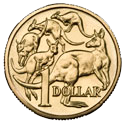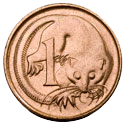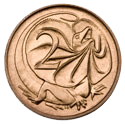Australian dollar
The official currency of Australia and several other territories
The Australian dollar (sign: $; code: AUD) is the currency of Australia, including its external territories. It is also used by three independent Pacific Island states: Kiribati, Nauru, and Tuvalu. Within Australia, it is almost always abbreviated with the dollar sign ($), with A$ or AU$ sometimes used to distinguish it from other dollar-denominated currencies.
History[edit | edit source]
The Australian dollar was introduced on 14 February 1966, replacing the Australian pound, which had been in use since 1910. The change was part of a decimalisation process, where the new currency was divided into 100 cents, replacing the previous system of pounds, shillings, and pence.
The decision to adopt the dollar was made in 1963, and the name "royal" was initially proposed for the new currency. However, "dollar" was eventually chosen, and the transition to the new currency was completed smoothly.
Coins and Banknotes[edit | edit source]
The Australian dollar is subdivided into 100 cents. The coins in circulation include 5, 10, 20, and 50 cent coins, as well as $1 and $2 coins. The banknotes in circulation are $5, $10, $20, $50, and $100.
The Royal Australian Mint is responsible for producing Australia's coins, while the Reserve Bank of Australia issues the banknotes. Australian banknotes are notable for being made of polymer, a technology that was pioneered in Australia and has since been adopted by many other countries.
Exchange Rates[edit | edit source]
The Australian dollar is a free-floating currency, meaning its value is determined by the foreign exchange market. It is one of the most traded currencies in the world, often used as a proxy for global risk appetite due to Australia's economic ties to Asia and its status as a major commodity exporter.
Economic Role[edit | edit source]
Australia's economy is heavily reliant on the export of commodities such as iron ore, coal, and natural gas. As a result, the value of the Australian dollar is often influenced by changes in commodity prices. The currency is also affected by interest rate differentials between Australia and other countries, as well as global economic conditions.
Monetary Policy[edit | edit source]
The Reserve Bank of Australia (RBA) is responsible for setting monetary policy in Australia. The RBA's primary objective is to maintain price stability, full employment, and the economic prosperity and welfare of the Australian people. It does this by setting the official cash rate, which influences interest rates across the economy.
Also see[edit | edit source]
- Reserve Bank of Australia
- Royal Australian Mint
- Economy of Australia
- Australian pound
- Decimalisation
- Polymer banknote
Search WikiMD
Ad.Tired of being Overweight? Try W8MD's physician weight loss program.
Semaglutide (Ozempic / Wegovy and Tirzepatide (Mounjaro / Zepbound) available.
Advertise on WikiMD
|
WikiMD's Wellness Encyclopedia |
| Let Food Be Thy Medicine Medicine Thy Food - Hippocrates |
Translate this page: - East Asian
中文,
日本,
한국어,
South Asian
हिन्दी,
தமிழ்,
తెలుగు,
Urdu,
ಕನ್ನಡ,
Southeast Asian
Indonesian,
Vietnamese,
Thai,
မြန်မာဘာသာ,
বাংলা
European
español,
Deutsch,
français,
Greek,
português do Brasil,
polski,
română,
русский,
Nederlands,
norsk,
svenska,
suomi,
Italian
Middle Eastern & African
عربى,
Turkish,
Persian,
Hebrew,
Afrikaans,
isiZulu,
Kiswahili,
Other
Bulgarian,
Hungarian,
Czech,
Swedish,
മലയാളം,
मराठी,
ਪੰਜਾਬੀ,
ગુજરાતી,
Portuguese,
Ukrainian
Medical Disclaimer: WikiMD is not a substitute for professional medical advice. The information on WikiMD is provided as an information resource only, may be incorrect, outdated or misleading, and is not to be used or relied on for any diagnostic or treatment purposes. Please consult your health care provider before making any healthcare decisions or for guidance about a specific medical condition. WikiMD expressly disclaims responsibility, and shall have no liability, for any damages, loss, injury, or liability whatsoever suffered as a result of your reliance on the information contained in this site. By visiting this site you agree to the foregoing terms and conditions, which may from time to time be changed or supplemented by WikiMD. If you do not agree to the foregoing terms and conditions, you should not enter or use this site. See full disclaimer.
Credits:Most images are courtesy of Wikimedia commons, and templates Wikipedia, licensed under CC BY SA or similar.
Contributors: Prab R. Tumpati, MD




